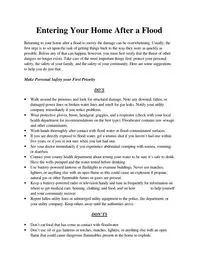
Flood - Entering your home after PDF
Preview Flood - Entering your home after
Entering Your Home After a Flood Returning to your home after a flood to survey the damage can be overwhelming. Usually, the first urge is to set upon the task of getting things back to the way they were as quickly as possible. Before any of that can happen, however, you must first verify that the threat of other dangers no longer exists. Take care of the most important things first: protect your personal safety, the safety of your family, and the safety of your community. Here are some suggestions to help you do just that... Make Personal Safety your First Priority DO’S • Walk around the premises and look for structural damage. Note any downed, fallen, or damaged power lines or broken water lines and smell for gas leaks. Notify your utility company immediately if you notice problems. • Wear protective gloves, boots, headgear, goggles, and a respirator (check with your local health department for recommendations on the best type). Floodwater contains raw sewage and other contaminants. • Wash hands thoroughly after contact with flood water or flood-contaminated surfaces. • If you are directly exposed to flood water, get a tetanus shot if you haven’t had one within five years, or if you’re not sure when you last had one. • See your doctor immediately if you experience abdominal cramping with nausea, vomiting, or diarrhea. • Contact your county health department about testing your water to be sure it’s safe to drink. Have the wells pumped and the water tested before drinking. • Use battery-powered lanterns or flashlights to examine buildings. Never use matches, lighters, or anything else with an open flame as this could cause an explosion if propane, natural gas or other flammable fumes or gases are present. • Keep a battery-powered radio or television handy and tune in frequently for information on where to get medical care, housing, clothing, and food, and on how to help yourself and your community recover. • Report fallen utility lines or submerged utility equipment to the police, fire department, or your utility company. Keep others away until the authorities arrive. DON’TS • Don’t eat food that has come in contact with floodwater. • Don’t use oil or gas lanterns or torches, matches, lighters, or anything else with an open flame that could cause dangerous flammables present in the home to explode. • Don’t handle live electrical equipment in wet areas. Always have a professional check and dry electrical equipment before returning it to service. If you’re uncertain whether equipment is live, assume it is. • Don’t visit the disaster area unnecessarily. Your presence may hamper rescue and other emergency operations. • Don’t restart any electrical equipment before having it assessed by a qualified contractor. Submersion of electric or gas heating and cooling equipment can cause system damage. Restarting without proper inspection could result in electrical shock, fire hazard, carbon monoxide poisoning, or explosion. • Don’t go near a submerged or overflowing septic tank, or try to service it yourself in any way. If you have a pumped system, disconnect the power to the system before checking it, and don’t restart the system without having it professionally checked and serviced. Entering the Home DO’S • Turn off the power in your home as soon as it is safe to enter, even if the utility has turned power off in your neighborhood. • Turn all electricity off at the main breaker/fuse box. • Use a dry wooden stick to switch off the main breaker, if necessary, instead of stepping in water to reach the electrical box. • Shut off the gas by turning the handle of the gas valve perpendicular to the pipe. If the valve handle is parallel to the pipe, the gas is on. • Leave the premises immediately if you smell gas. • Check for broken or leaking water pipes. If you find any, turn off the water at the main pipe. If your pipes don’t appear to be leaking or broken, you can use tap water for hosing and some cleaning, but not for drinking, cooking, or washing dishes or clothes until you’re sure it’s safe. • Find and protect valuable items. Wash mud off items if possible and move them to another location for safekeeping. • Step carefully as water and mud can make floors very slippery. Also watch out for loose flooring and ceilings that are sagging, as well as for snakes and animals. DON’TS • Don’t step in water when turning off the electricity in your home. Instead, use a dry wooden stick to switch off the main breaker, if necessary. • Don’t ignore the importance of turning off power in your home, regardless of whether the utility company has turned it off in your neighborhood. The utility company may restore power without warning. • Don’t try to pick up or clean everything until the more important things are taken care of.
